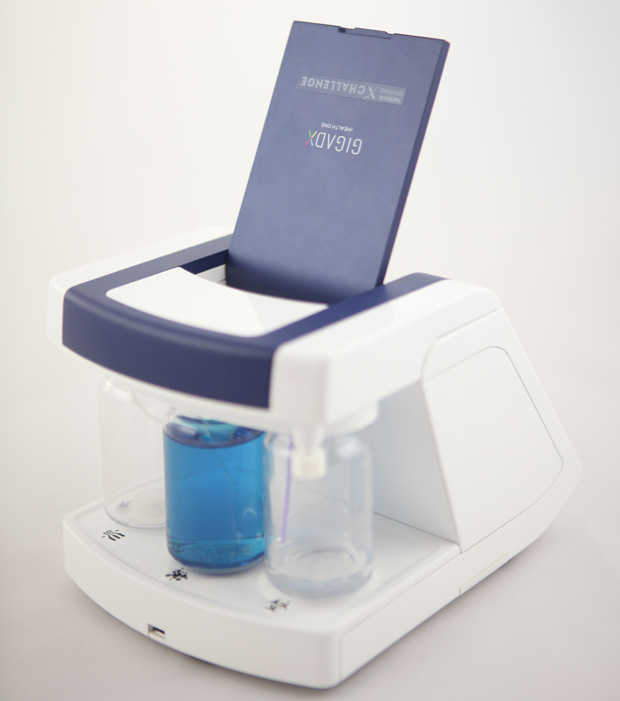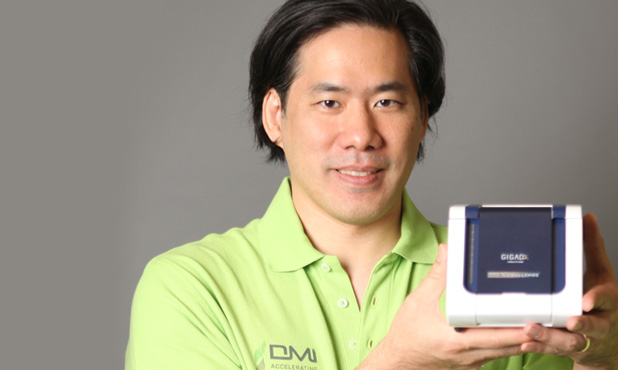Above: Eugene Chan with the rHEALTH.
Right now, it’s an unimposing device about the size of a tissue box, with a hinged lid on one side. But this little machine carries a big punch: it embodies a novel approach to diagnosing a multitude of diseases and monitoring many health parameters. Its miniaturized systems for sample processing, microfluidic laser-fluorescence imaging, and readout analytics systems are capable of running hundreds of tests at once, for anything from blood glucose levels to HIV markers. A preliminary version of this system just became available for research purposes, at the moment carrying out one test at a time, but there’s no real limit on additional ones that can be done essentially simultaneously—it just depends on the mix of detector molecules in the fluid that gets mixed in with a single droplet of blood.
An early version of this little powerhouse device won the Nokia Sensing Challenge in November 2014, and the team behind it is pressing ahead to meet the next challenge, a fully portable multi-diagnostic version competing for the Qualcomm Tricorder X-Prize. The device is called rHEALTH, which stands for reusable Handheld Electrolyte and Lab Technology for Humans.

Founder and CEO Eugene Chan says his team of engineers at DNA Medicine Institute’s headquarters in Cambridge, Massachusetts, is making great strides toward achieving this long-sought goal of a simple, lightweight device that could diagnose a multitude of disease conditions and monitor a wide range of vital signs continuously. In fact, clinical trials of a prototype could start within two years. But the company’s real goal is enabling widespread, easy, and inexpensive technology that lets people take real control over their own health monitoring—and that could potentially alleviate overloads on emergency systems by allowing patients to know when they really need a hospital’s care, and when they should just stay home.
The rHEALTH “universal health sensor” system got its start in 2008 as a research project with NASA’s Glenn Research Center, under a program to enable better remote diagnostic capabilities for astronauts on the International Space Station, where professional medical care is usually not an option. In 2010, NASA funded a series of tests of the experimental devices by Chan and his associates under zero-gravity conditions on parabolic test aircraft flights.
What the company essentially did was to shrink conventional antibody-based biosensors, developed to fluoresce in response to the presence of biomarkers known to be associated with particular diseases, and then read out those fluorescent signals at high speed. Such sensors are usually used at a macro-scale, such that a technician can read the results visually, but DMI has developed ways to shrink the essential chemistry behind such test strips down to the nanoscale, using a novel photolithography technique and novel chemistry, Chan says. That allows them to minimize the amount of blood that needs to be drawn, and allows many more tests from a single sample. One key to that is a sample-preparation miniaturized mixer they call a spiral vortexer.
Already, the system can perform dozens of tests within seconds, from a single pinprick’s worth of blood, as compared to conventional lab tests that require a whole vial of blood and may take hours to carry out. And the basic sensor is just the size of a matchbox, Chan says. Preliminary initial field testing could begin within a year or so, he says, to gain FDA approval, at first with a single diagnostic test at a time.
Testing so far shows that the miniaturized tests strips, which require as little as one-thousandth as much blood per test as conventional tests, can match, and in some cases even exceed, the accuracy of those lab-based tests, Chan says.
Before he started DMI, Chan—who holds an MD from Harvard Medical School through the Harvard-MIT Health Sciences and Technology program—had started a number of other companies, including U.S. Genomics, which makes DNA analysis devices based on his approach of single-molecule fluorescent scanning. It was that concept that led to the system used in the rHEALTH scanner. Chan holds more than 50 issued or pending patents himself, and his various companies have raised funding of more than US$120 million so far.
The basic biochemistry behind the various diagnostics that the rHEALTH device will test for are standard lab test materials. It’s the way they get used in this highly miniaturized system that gives the system its innovative edge in convenience.
One droplet of blood gets mixed together with a solution containing the various test nanostrips, which then goes to the spiral vortexer, which mixes them thoroughly. A microfluidic system then allows the tiny strips to pass through an optical block—an array of lasers and detectors that can identify each of the different types of strips and their activity levels. The nanostrips are essentially barcoded: “There is unique coding information associated with each strip, a color signal that identifies that nanostrip,” Chan explains, which allows that test type to be correlated with the intensity of that strip’s fluorescence. Each one goes by in a millionth of a second, he says. The results then go straight to a computer via Bluetooth link, to be logged and analyzed. A basic single-test version of the device, called rHEALTH 1, went on sale in January through a subsidiary company, but only for research purposes, not yet for clinical use.
At this point, in terms of getting the system from the lab to doctors’ offices and clinics, and eventually to people’s medicine cabinets, one of the questions is just how much testing capability will they be able to include in an eventual multi-diagnostic tool for home use. “How do we economically get as many tests as possible through the FDA,” Chan wonders—a process that can take six months or more for a single test. The company hopes to be able to get whole suites of tests approved as a group instead. So far, they have developed a wide variety of standard hematology tests, including cell counts and blood chemistry such as proteins, glucose, and cytokines.
In the meantime, they got a boost from their victory last November in the Nokia Sensing Challenge, where they beat a field of ten other finalist teams made up of professors, industry researchers, and students from places including Harvard, MIT, and Stanford, and from France, Switzerland, and the United Kingdom, which earned them US$525,000 of new funding. Now the company is gearing up for this summer’s start of judging in the final round for the Qualcomm Tricorder X-Prize’s US$10 million prize, which will be awarded next January. The long judging process among the ten finalist teams will involve multiple trials of all the different diagnostic tests—16 specific tests are required, for everything from flu to HIV. The competition also requires the ability to monitor a set of five vital signs for an extended period—pulse and respiration rates, blood pressure, temperature, and blood oxygen—something DMI does using a single separate module that can be affixed to the chest like a small bandage.
Some of the teams competing for that prize, Chan says, are using “a lot of cobbled-together existing technology. We’ve taken a different approach,” using a technology that can detect a wide variety of parameters using a single basic mechanism. And if that combination continues to demonstrate its performance on new tests as well as it has so far, the new device could provide a dramatic new capability for initial diagnostics in homes, in remote areas, and medically under-served regions, in clinics—and maybe even in space, bringing the project full circle to its initial origins.



